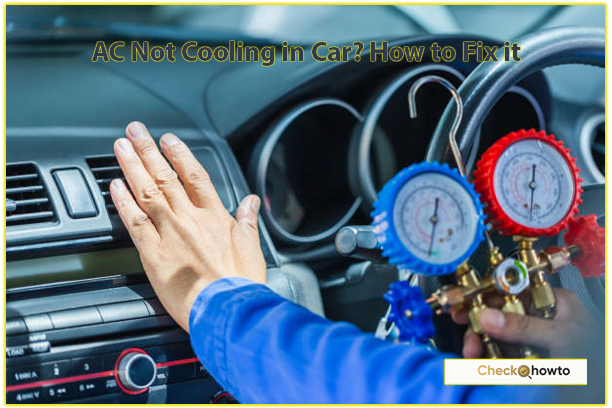When the air conditioning (AC) in your car stops cooling, it can turn even the shortest drive into an uncomfortable experience. I’ve been there, sweating through my shirt, wondering why the cool breeze I rely on has suddenly disappeared. If you’re facing the same issue, don’t worry I’m here to guide you through the process of diagnosing and fixing your car’s AC system. Whether you’re a seasoned DIY enthusiast or a beginner, this article will provide you with the knowledge and steps to get your car’s AC blowing cold air again.

In this guide, I’ll walk you through the common reasons why your car’s AC might not be cooling, how to troubleshoot the problem, and the steps you can take to fix it. I’ll also share some tips on maintaining your car’s AC system to prevent future issues.
Related; AC Not Cooling the House? How to Fix It
Why Is My Car’s AC Not Cooling?
Before jumping into fixes, it’s important to understand why your car’s AC might not be cooling. The AC system in your car is a complex network of components working together to cool the air. If any of these components fail or malfunction, the system won’t work as it should. Here are some common reasons why your car’s AC might not be cooling:
- Low Refrigerant Levels: Refrigerant is the lifeblood of your car’s AC system. If the refrigerant level is low, the system won’t be able to cool the air effectively.
- Faulty Compressor: The compressor is responsible for circulating the refrigerant through the system. If it’s not working, the AC won’t cool.
- Clogged or Leaking Condenser: The condenser releases heat from the refrigerant. If it’s clogged or leaking, the system won’t cool properly.
- Broken Cooling Fan: The cooling fan helps dissipate heat from the condenser. If it’s not working, the AC system can overheat.
- Electrical Issues: Faulty wiring, blown fuses, or a malfunctioning AC switch can prevent the AC from working.
- Dirty or Blocked Air Filters: If the air filters are clogged, airflow will be restricted, reducing the cooling efficiency.
- Damaged Blower Motor: The blower motor pushes air through the vents. If it’s not working, you won’t feel any air coming out.
Now that we’ve identified the potential causes, let’s move on to troubleshooting and fixing the issue.
Step 1: Check the Refrigerant Level
One of the most common reasons for a car’s AC not cooling is low refrigerant levels. Refrigerant is a substance that absorbs heat from the air inside your car and releases it outside. Over time, refrigerant can leak out, reducing the system’s efficiency.
How to Check Refrigerant Levels
- Locate the Low-Pressure Port: Open your car’s hood and locate the low-pressure port on the AC system. It’s usually marked with an “L” and has a blue or black cap.
- Use a Refrigerant Gauge: Attach a refrigerant gauge to the low-pressure port. The gauge will show you the current pressure level.
- Compare with Manufacturer’s Specifications: Check your car’s manual for the recommended refrigerant pressure. If the pressure is low, you’ll need to add more refrigerant.
Adding Refrigerant
- Purchase the Right Refrigerant: Make sure you buy the correct type of refrigerant for your car. Most modern cars use R-134a, but some newer models use R-1234yf.
- Attach the Refrigerant Can: Connect the refrigerant can to the low-pressure port using a hose.
- Add Refrigerant: Slowly add refrigerant to the system while monitoring the pressure gauge. Be careful not to overfill, as this can damage the AC system.
If adding refrigerant doesn’t solve the problem, you may have a leak in the system. In that case, it’s best to take your car to a professional mechanic for further inspection.
See; 11 Mistakes to Avoid When Buying a New Car
Step 2: Inspect the AC Compressor
The AC compressor is the heart of your car’s AC system. It’s responsible for compressing the refrigerant and circulating it through the system. If the compressor isn’t working, the AC won’t cool.
How to Check the AC Compressor
- Start the Engine and Turn on the AC: With the engine running, turn on the AC and set it to the coldest setting.
- Listen for the Compressor: Open the hood and listen for the compressor engaging. You should hear a click followed by a humming sound.
- Check the Compressor Clutch: Look at the compressor pulley. If the clutch isn’t engaging, the compressor isn’t working.
Fixing a Faulty Compressor
If the compressor isn’t working, it may need to be replaced. This is a complex task that usually requires professional help. However, before replacing the compressor, check the following:
- Fuses and Relays: A blown fuse or faulty relay can prevent the compressor from working. Check your car’s fuse box and replace any blown fuses.
- Electrical Connections: Inspect the wiring connected to the compressor. Loose or corroded connections can prevent the compressor from engaging.
Step 3: Clean or Replace the Condenser
The condenser is located in front of your car’s radiator and is responsible for releasing heat from the refrigerant. If the condenser is clogged with dirt or debris, it won’t be able to dissipate heat effectively, reducing the cooling efficiency.
How to Clean the Condenser
- Locate the Condenser: Open the hood and find the condenser in front of the radiator.
- Remove Debris: Use a soft brush or compressed air to remove any dirt, leaves, or debris from the condenser fins.
- Flush with Water: Gently flush the condenser with water to remove any remaining dirt. Be careful not to damage the fins.
If the condenser is damaged or leaking, it will need to be replaced. This is a job best left to a professional mechanic.
Step 4: Check the Cooling Fan
The cooling fan helps dissipate heat from the condenser. If the fan isn’t working, the AC system can overheat, reducing its cooling efficiency.
How to Check the Cooling Fan
- Start the Engine and Turn on the AC: With the engine running and the AC on, check if the cooling fan is spinning.
- Inspect the Fan Motor: If the fan isn’t spinning, the motor may be faulty. Check the wiring and connections to the fan motor.
Fixing a Faulty Cooling Fan
If the cooling fan isn’t working, it may need to be replaced. This is a relatively simple task that you can do yourself if you’re comfortable working with car electronics. However, if you’re unsure, it’s best to consult a professional.
Step 5: Inspect the Air Filters
Dirty or clogged air filters can restrict airflow, reducing the cooling efficiency of your car’s AC system. Most cars have two types of air filters: the cabin air filter and the engine air filter.
How to Check and Replace Air Filters
- Locate the Cabin Air Filter: The cabin air filter is usually located behind the glove box or under the dashboard.
- Remove and Inspect the Filter: Take out the cabin air filter and inspect it for dirt and debris. If it’s dirty, replace it with a new one.
- Check the Engine Air Filter: The engine air filter is located under the hood, usually in a black plastic box. Remove the filter and inspect it for dirt. Replace it if necessary.
Step 6: Test the Blower Motor
The blower motor is responsible for pushing air through the vents. If the blower motor isn’t working, you won’t feel any air coming out of the vents, even if the AC is cooling.
How to Test the Blower Motor
- Turn on the AC: Set the AC to the highest fan speed.
- Listen for the Blower Motor: If you don’t hear the blower motor running, it may be faulty.
- Check the Fuses and Wiring: Inspect the fuses and wiring connected to the blower motor. Replace any blown fuses or repair any damaged wiring.
Replacing the Blower Motor
If the blower motor is faulty, it will need to be replaced. This is a relatively simple task that you can do yourself if you’re comfortable working with car electronics. However, if you’re unsure, it’s best to consult a professional.
Step 7: Check for Electrical Issues
Electrical issues can prevent your car’s AC from working properly. Common electrical problems include blown fuses, faulty relays, and damaged wiring.
How to Check for Electrical Issues
- Inspect the Fuses: Check your car’s fuse box for any blown fuses related to the AC system. Replace any blown fuses.
- Test the Relays: Use a multimeter to test the relays connected to the AC system. Replace any faulty relays.
- Inspect the Wiring: Check the wiring connected to the AC system for any signs of damage or corrosion. Repair or replace any damaged wiring.
Step 8: Maintain Your Car’s AC System
Regular maintenance can prevent many of the issues that cause your car’s AC to stop cooling. Here are some tips for maintaining your car’s AC system:
- Check Refrigerant Levels Regularly: Low refrigerant levels are a common cause of AC problems. Check the refrigerant levels regularly and top up if necessary.
- Clean the Condenser: Keep the condenser clean and free of debris to ensure it can dissipate heat effectively.
- Replace Air Filters: Replace the cabin air filter and engine air filter regularly to ensure proper airflow.
- Inspect the Compressor: Regularly inspect the compressor for signs of wear and tear. Replace it if necessary.
- Test the Blower Motor: Test the blower motor regularly to ensure it’s working properly.
See; Why Is My AC Running But Not Cooling?
Conclusion
Dealing with a car AC that’s not cooling can be frustrating, but with the right knowledge and tools, you can diagnose and fix the problem yourself. In this guide, I’ve walked you through the common reasons why your car’s AC might not be cooling, how to troubleshoot the issue, and the steps you can take to fix it. Remember, regular maintenance is key to keeping your car’s AC system running smoothly.
If you’re ever in doubt or the problem seems too complex, don’t hesitate to seek professional help. A qualified mechanic can diagnose and fix the issue quickly and efficiently, ensuring your car’s AC is back to blowing cold air in no time.
By following the steps outlined in this article, you’ll be well on your way to enjoying a cool and comfortable ride, no matter how hot it gets outside. Safe driving!



